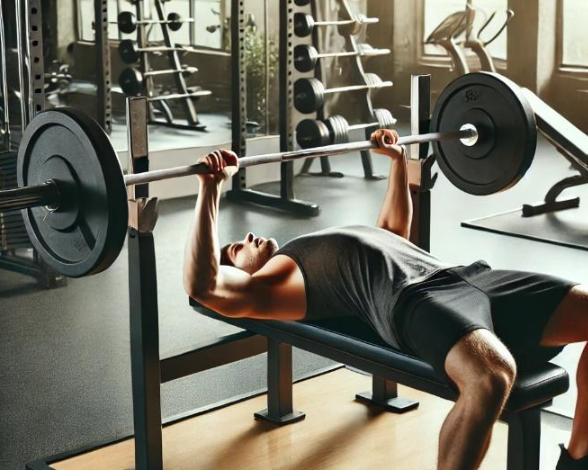Key Muscles Targeted by the Bench Press: A Comprehensive Guide

The flat bench press has become synonymous with strength training, offering a solid foundation for building upper body power and muscle mass. This seemingly simple exercise, performed on a flat press bench, has evolved over the years into a cornerstone movement in gyms across the world. Let’s explore the evolution of the flat bench press and why it’s vital for your workout routine.
The primary muscles Targeted by Bench Presses
When you perform a bench press, the primary muscles engaged are the pectorals, or chest muscles. Specifically, the pectoralis major and minor are heavily involved in the pressing motion. These muscles are responsible for the pushing movement that extends your arms and presses the weight away from your body.
- Pectoralis Major: The bench press primarily targets the pectoralis major, the thick, fan-shaped muscle that covers most of the chest. This muscle is responsible for movements like pushing and lifting, which is why it’s so heavily activated during bench presses. A strong pectoralis major helps improve upper body strength and enhances performance in a variety of other exercises.
- Pectoralis Minor: This smaller muscle is located underneath the pectoralis major and plays a supporting role in stabilizing the shoulder during the bench press. While it doesn’t get as much attention as the major, the pectoralis minor is essential for the smooth execution of pushing movements.
Secondary muscles involved in bench presses
Beyond the chest, the bench press also involves several secondary muscle groups. These include the shoulders (deltoids), triceps, and even your core muscles.
- Deltoids: The anterior, or front, portion of the deltoids (shoulder muscles) are highly engaged during the bench press. These muscles assist in the lifting motion, especially as you press the weight away from your chest. Strong deltoids contribute to shoulder stability and enhance the overall strength needed for pressing movements.
- Triceps: Located on the back of your upper arms, the triceps are another critical muscle group engaged during bench presses. As your arms extend to push the weight, the triceps work to straighten the elbows. Regular bench pressing can significantly increase triceps strength, which is essential for many other upper-body exercises.
- Serratus anterior: The serratus anterior is a muscle located along the sides of your ribcage. This muscle plays a vital role in shoulder stability and is also engaged during the bench press as it helps control the movement of your shoulder blades. Strengthening the serratus anterior can improve your overall posture and stability during other lifts.
- Core Muscles: Although the bench press is primarily an upper-body exercise, your core muscles (including the abdominals and obliques) are also activated to maintain stability and balance while lifting. A strong core is essential to prevent excessive arching of the back, which can lead to injury during heavy lifts.
The Importance of Using the Right Bench
To maximize the benefits of the bench press, using the right equipment is crucial. A solid, stable flat press bench allows you to perform the exercise with proper form, preventing injuries and ensuring effective muscle engagement. For example, the Insight Fitness DR014B Flat Bench is an excellent option for both beginners and experienced lifters due to its features:
- Great Frame: A sturdy frame ensures that the bench is stable and can support the weight of both the lifter and the weights being used. This is particularly important for heavier lifters or those looking to lift heavy weights.
- Rubber Feet: The rubber feet on the Insight Fitness DR014B prevent the bench from slipping or moving during use, adding an extra layer of safety during your workout.
- Design for Dumbbell and General Exercise Usage: Versatility is another important feature of this flat press bench. It’s designed to accommodate not only bench presses but also a variety of other exercises, including dumbbell presses, flyes, and general resistance training.
- By choosing a high-quality flat bench like the Insight Fitness DR014B, you can ensure that your bench pressing is both safe and effective. The design and construction of the bench help you maintain proper form, which is key to targeting the muscles you want to build without risking injury.
Variations of the Bench Press
There are several variations of the bench press, and each one emphasizes different muscle groups. While the traditional flat bench press targets the overall chest, incorporating other variations can help develop specific parts of the chest and supporting muscles.
- Incline Bench Press: In this variation, the bench is set at an angle, and the incline helps target the upper part of the pectoralis major. This movement also shifts more emphasis onto the shoulders.
- Decline Bench Press: The bench is set at a decline angle, and this variation targets the lower portion of the chest muscles. The triceps also play a more significant role in this movement compared to the flat bench press.
- Dumbbell Bench Press: Using dumbbells instead of a barbell engages more stabilizing muscles, including those in the shoulders and core, as each arm works independently. This variation can be performed on a flat, incline, or decline bench for variety.
Conclusion: Why Bench Presses Are Essential for Upper Body Development
The evolution of the flat bench press reflects the progression of strength training itself—from rudimentary weightlifting techniques to scientifically optimized movements. Today, the flat press bench remains a critical piece of equipment, and the bench press continues to be one of the most effective exercises for building upper body strength. As strength training continues to evolve, the flat bench press machine will undoubtedly remain important for muscle-building routines, helping individuals achieve greater strength, endurance, and overall fitness.
